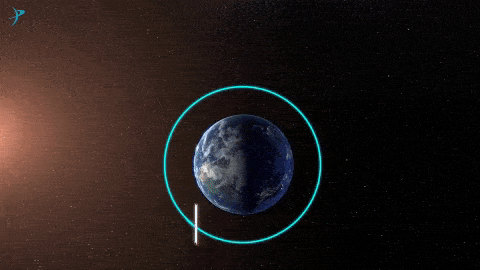
Image taken during the LightSail 2 sail deployment sequence on 23 July 2019. Credit: The Planetary Society.
In 1976, Carl Sagan went on the Tonight Show with Johnny Carson where he presented at exciting and extraordinary technology: solar sailing.
Like a ship’s sails harness the wind to move forward, solar sailing allows a spacecraft to move through space using nothing but the pressure of sunlight. More than four decades later, the Planetary Society, a nonprofit organization that promotes the exploration of space through education, has demonstrated the technology’s potential in the real world. They launched a tiny spacecraft that was able to raise its orbit using the power of the sun alone — a world first.
“We’re thrilled to announce mission success for LightSail 2,” said Bruce Betts, LightSail program manager and the Society’s chief scientist, in a statement.
“Our criteria was to demonstrate controlled solar sailing in a CubeSat by changing the spacecraft’s orbit using only the light pressure of the Sun, something that’s never been done before.”
SAIL DEPLOYMENT COMPLETE! We're sailing on SUNLIGHT!!!!! pic.twitter.com/PA74NMa7Ry
— Planetary Society (@exploreplanets) July 23, 2019
The Lightsail 2 spacecraft that recently reached this milestone took over a decade and $7 million in crowdfunding to develop. For the past month or so, the spacecraft has been in orbit after it was launched with other payloads aboard a SpaceX Falcon Heavy rocket. Last week it opened its sails for the first time. Since then, LightSail 2 has raised its orbit by 1.7 kilometers (slightly over a mile), solely due to the pressure of photons.
Nothing to do with solar panels — more to do with sailing
The LightSail is features a very simple design. Essentially, it looks very much like a kite. The sail is made out of thin Mylar and when it’s fully stretched out, it measures 345 square feet.
Interestingly, LightSail is not a novel concept at all. Nearly 400 years ago, when much of the world thought that reaching North America was a monumental achievement, Johannes Kepler proposed the idea of exploring the galaxy using sails. The astronomer thought the tails of the comets he was observing were actually blown away by some kind of solar breeze, so naturally, this sort of idea of using a solar sail came to mind. This is obviously not true since there’s no “real” wind in space, but we do know that sunlight can exert enough pressure to move objects.
Sunlight pressure offered “tiny push no stronger than the weight of a paperclip” each time the spacecraft completed an orbit around Earth, according to the Planetary Society.
That might not sound like much, but the reality is that many scientists believe that this technology might someday help humans become an interstellar species. Because there’s very little to no resistance in space, light sail-powered spacecraft gain more and more momentum as they travel and an increasing number of photons bounces off the sail. As long as photons hit the sail, the spacecraft will endlessly continue to accelerate — at least in theory. So, even though you still need a rocket to lift such a spacecraft in orbit, a solar sail can reach speeds that a chemical spacecraft could never ever attain.
What’s more, when the sunlight isn’t enough, powerful lasers on Earth pointed onto a sail could accelerate a spacecraft even further. According to NASA researchers, a solar sail pushed by lasers could technically reach Mars in only 3 days.
“It’s counter-intuitive, it’s surprising, and to me it’s very romantic,” Bill Nye, famed science communicator and president of The Planetary Society, told reporters during a a press call Wednesday, “to be sailing on sunbeams.”
“LightSail 2 proves the power of public support,” said Planetary Society COO Jennifer Vaughn. “This moment could mark a paradigm shift that opens up space exploration to more players. It amazes me that 50,000 people came together to fly a solar sail. Imagine if that number became 500,000 or 5 million. It’s a thrilling concept.”










